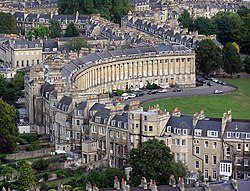| Royal Crescent | |
|---|---|
 Royal Crescent from a hot air balloon, contrasting its uniform public front façade against its more architecturally varied private rear. | |
| Location | Bath, Somerset, England |
| Coordinates | 51°23′13″N 2°22′06″W / 51.38694°N 2.36833°W |
| Built | 1767–1774 |
| Current use | Private residences |
| Architect | John Wood, the Younger |
| Architectural style(s) | Georgian |
Listed Building – Grade I | |
| Official name | Nos. 1–30, Royal Crescent |
| Designated | 12 June 1950[1] |
| Reference no. | 1394736 |
Listed Building – Grade II | |
| Official name | Five lamp columns |
| Designated | 15 October 2010[2] |
| Reference no. | 1394739 |
Listed Building – Grade II | |
| Official name | 1A, Royal Crescent |
| Designated | 5 August 1975[3] |
| Reference no. | 1394740 |
The Royal Crescent is a row of 30 terraced houses laid out in a sweeping crescent in the city of Bath, England. Designed by the architect John Wood, the Younger, and built between 1767 and 1774, it is among the greatest examples of Georgian architecture to be found in the United Kingdom and is a Grade I listed building. Although some changes have been made to the various interiors over the years, the Georgian stone facade remains much as it was when first built.
The 500-foot-long (150 m) crescent has 114 Ionic columns on the first floor with an entablature in a Palladian style above. It was the first crescent of terraced houses to be built and an example of "rus in urbe" (the country in the city) with its views over the parkland opposite.
Many notable people have either lived or stayed in the Royal Crescent since it was built over 240 years ago, and some are commemorated on special plaques attached to the relevant buildings. Of the crescent's 30 townhouses, 10 are still full-size townhouses; 18 have been split into flats of various sizes; One is the No. 1 Royal Crescent museum, and The Royal Crescent Hotel & Spa, at the centre of the crescent, is made up of No. 16 and No.15.
- ^ "Nos. 1-30 Royal Crescent". National Heritage List for England. Historic England. Archived from the original on 6 March 2017. Retrieved 5 March 2017.
- ^ "Five lamp columns". National Heritage List for England. Historic England. Archived from the original on 6 March 2017. Retrieved 5 March 2017.
- ^ "1A, Royal Crescent". National Heritage List for England. Historic England. Archived from the original on 13 March 2016. Retrieved 5 March 2017.
